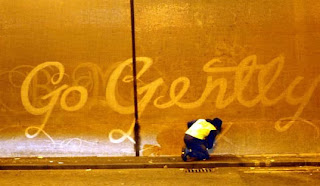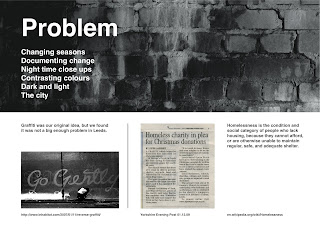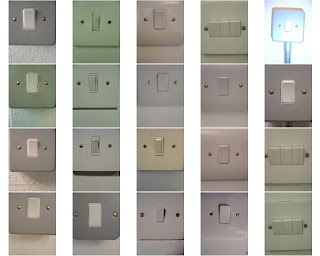Tuesday 15 December 2009
Collection 100... Research Proposal
Monday 14 December 2009
What If...
One story that caught my attention was about a gang operating in the city centre who snatch purses in supermarkets, relating back to the brief this would be an appropriate topic, it is a problem that will affect the public, the fact that the story is in the paper shows it is a genuine problem.
Another story that caught my attention was a drugs raid on a night club in the city centre, this would not affect as many people as the previous issue would, but it would still affect some sector of the general public.

After we shared all our research the subject homelessness was brought up, it wasn’t an idea that fell into place straight away as I think we as a group had our hearts set on the graffiti idea, however, a few more ideas were put forward on the subject of homelessness and as we as a group lacked knowledge on homelessness in Leeds, maybe the public lacked knowledge.
Meryem joined our group today as she had been away, so I gave her a brief overview of what the group had come up with, so she was as up to date as we were, instead of catching up and missing out on voicing her opinion.

When speaking to my Mum, she said some of the ‘clients’ are homeless because they are funding for their habit, so cannot afford rent etc. and some are homeless for whatever reason and end up on drugs. She also said that some are not technically classed as homeless as they ‘sofa-surf’ on friend’s sofas, so while they have no fixed address, they aren’t sleeping rough. This touched upon an issue we already faced, what exactly is homelessness, as there are different types, and the definition varies form country to country. For example the types of homelessness we have here are:
(taken from the Crisis website)
- Legally homeless: A household is legally homeless if either there is no accommodation that they are entitled to occupy or they have accommodation but it is not reasonable for them to continue to occupy this accommodation.
- Officially recognised as homeless: Those who are both legally homeless and have successfully applied to their local authority to be classified as such in the current year. A household can be legally homeless but not recognised by the state as being homeless because they have not applied to be classified as such.
- Statutory homeless: Households that have been found to be eligible for assistance, unintentionally homeless and falling within a priority need group and thus owed a main homelessness duty by a local housing authority.. In 2006-07, 73,360 households were accepted as statutory homeless in England. Local Authorities made 159,330 decisions on homelessness applications.
- Hidden homeless: This refers to homeless households, which may or may not have applied to local authorities for homeless status, but are not entitled to any accommodation. Crisis estimates that there are around 400,000 such 'hidden homeless' adults at any point in time.
We regrouped the following day to see what each other had found out, what was particularly interesting was the responses to the survey that was submitted on http://www.surveymonkey.com/, some of the questions were not worded correctly which lead to confusion, which meant the validity of the answers were not acceptable, and therefore I chose to ignore those answers. Sai and Nick analysed the answers in an attempt to formulate some statistics as part as our evidence.
71.4% of the respondents were 16-25, however some were in the 26-35, 36-45 and 56-65 category. The quantitative answers were much easier to analyse, and from this, the statistics could be generated, however, the qualitative answers were much more complex. A total of 28 participated, the majority being from Leeds, however there were responses from Scunthorpe, Nottingham, Birmingham, Manchester, Lincoln and Wisconsin, USA.
60.7% of the respondents felt that homelessness is an issue in their city of residence. Another question that was asked is, ‘How do you feel when you see a homeless person?’ I personally did not expect the answers that were given, the majority of people, did seem to have a lot of sympathy towards homeless people. 80.8% said that when they saw a homeless person they just walked on past them, and 11.5% said they would give them money. There was an opportunity on this question to give a qualitative answer, where someone even commented that they had housed a homeless person before.
Another interesting question was ‘Why do you think people are homeless?’ the vast majority assumed that the main cause was substance misuse and family/relationship breakdowns. Other answers included financial difficulties, a fairly obvious cause, mental health issues, disability, and job loss. After research on the Leeds City Council website, one of the most common causes of homelessness is parental eviction and domestic violence.
When asked, ‘Do you think there is enough help for the homeless in your city of residence?’, 69.6% thought no, there was not enough help. Again, there was an opportunity to make a comment on this, 10 people made a comment, around half of which were unsure of what help is actually available, one comment made was ‘…there needs to be initiatives to stop people becoming homeless, rather than to help them when they are.’ I think this comment is correct, but there still needs to be a lot of help for those who are homeless, as it is not something that can be easily prevented sometimes.
Nick had taken out a book from the library about the St. George’s Crypt, which is a charity that cares for homeless people in Leeds, and has done so for around 80 years. I went on to the website to find out more information and read an interview with a homeless man called Dougie, who has now passed away, he went to university and after finishing travelled the world, got married and had children, but sadly his wife was diagnosed with breast cancer, and that is where Dougie’s downward spiral started, as when his wife died he began drinking more and more, which resulted in losing his house, children and job. It wasn’t until he ended up in hospital in a coma that he realised he needed to stop drinking.
As a further point of research, I then decided it may be appropriate to contact St. George’s Crypt to ask a few questions as this may help us to identify a more specific issue. I rang the crypt up and spoke to a gentleman named Martin, (who I believe is in charge of fund raising) after introducing myself and explaining a little about the brief, I asked ‘How many people of no fixed residence use the facilities?’ To this Martin replied, that on average about 60 a day come along to the crypt, and roughly 15 turn up at night. This made me wonder where the rest of them stayed for the night. Another question I asked was, ‘Without the public donating money or volunteering, in what ways could they help out’, the reason behind this question was, not everyone has the time or money to help, so it might be good to raise public awareness of how they can help out. The reply to this was that people could donate old clothes and blankets etc. which is partially the response I expected; however I was not expecting the next part of the answer, in which Martin said, that they would welcome people with skills such as teachers who could help out.
Due to the first part of the brief being about photography, we felt that photography may be an interesting point to research, 2 of my Black and White film photographs were of a gutter with rubbish and leaves which was quite an interesting image, and we felt that this may be a suitable type of image to use. I thought that may be some photographers that have taken photos of homeless people; I found one book in the library but this was from less economically developed countries, so it wouldn’t have been appropriate. I think there was an absence of photos as some sites claimed that photographing homeless people was actually illegal, however some claimed it wasn’t. It was then that Hazel came up with an idea that maybe photographing someone acting as a homeless person may be unnecessary, and I guess it is also a little inappropriate, but then she suggested that we could use an image of where a homeless person may have sat. Looking back now I realise, this was a waste of time making these decisions as we had not yet identified a problem.
For the presentation on Friday, we had 3 A3 boards to create, Will and Meryem were in charge of our first board; the problem. Nick and Sai were focussing on condensing the group’s research to ensure only relevant research was featured on the board. Hazel and I worked on the intentions board. The boards needed to be created, and from mine and Hazel’s past experience of working in a group we decided that to create the boards, one person should sit at the computer, Hazel, and the others would sit around and we would all have an equal say. This is better than the entire group going away and all creating something completely different which would then need to be negotiated. Everyone had a say on all the boards, but there were 2 main people assigned to each board, who would talk about that particular board in the presentation.
Our intentions were to have the general public as the target audience, particularly older people who may have more time, and our objective was to inform and educate them as to how they can effectively help the homeless without donating, this would be done in the form of a campaign. The boards were finished in good time, which gave us time to have two rehearsals in the tutorial room and have some lunch. We were very confident and felt positive about our presentation, this was reflected in the feedback we got from our tutor, Amber and a few peers who thought we had presented a strong presentation and had carried out lots of research. Our tutor gave us a lot of positive feedback and this boosted the positive vibe of the group even more.
Before we had chance to start the presentation one of the tutors, Fred had left the group. Because of this, we decided to get his feedback on our ideas, afterall, the more feedback we have the better. There were a few comments made from other peers about our ideas after the presentation commenting on the design of our boards, this is something we took quite seriously, and tried to aim for a professional look.



Fred had pointed out that the issue we were dealing with was too big for such a small time-scale brief, and basically told us to go away and find more problems that stem from homelessness. The group had a small chat before we went home for the weekend, and we all tried to look into issues within homelessness, that we could use as a problem. Amber was really pleased with the amount of research we had carried out, and thought the presentation was a positive reflection of the group's work.
Sunday 6 December 2009
Collection 100... Photography
A list of photographers was provided to help with research such as; Martin Parr, John Rankin, David Bailey and more.
The mandatory requirements for this was to have 100 (7.5cmx6cm) hard copies of photos with no white borders, but all cut to size. Within the photographs needed to be evidence of experimentation with composition and the interpretation of the images.
I also used a few photos from my holiday in July 2009 to Tenerife, of the rocky landscape, one photograph features part of Mount Teide, a volcano. I chose to use these images as the colours are warm and which makes a contrast with the photos taken for the project.
These photos featured mainly objects, people and words, and were also mainly in colour, as these were in colour I have tried to make the photographs colourful to contrast with the schemes used in the other photographs, for example, a sunset, a purple scarf, a lava lamp etc.
Here are a selection of my photos:
Looking at the photographs I had to pick a theme that linked them altogether, this proved to be quite tricky as some of my images were a little random, I then decided that changing seasons may be an appropriate topic.
Once the photos were collated, the next part of the brief was given out, titled ‘What If’ and the class was divided into groups. In my group, there was Hazel, Will, Sai and Nick, and their themes were:
- Documenting changes – differences and similarities
- Contrasting colours
- Dark and light and things that shine in the night
- Night time close-ups.
With the themes the others had, I felt like my subject fitted in quite well, as with seasons changing there are contrasts in colours, differences and similarities across the seasons, the difference in dark and light is also affected by this.
Tuesday 1 December 2009
Visual Language... Photography
Here is a sample of what we found:


